Work Life Balance, Motivation Theories and Employee Relations
VerifiedAdded on 2022/12/27
|12
|3482
|61
Report
AI Summary
This report examines the concept of work-life balance and its impact on employer-employee relations, focusing on how organizations can enhance employee motivation. It analyzes the chosen trend of work-life balance, exploring the application of Maslow's hierarchy of needs (content theory) and Equity theory (process theory). The report critiques these theories, highlighting their strengths and weaknesses in the context of the chosen trend. Furthermore, it provides practical recommendations for improving employee motivation, including training, communication, and rewards and benefits, all supported by relevant academic literature. The report emphasizes the importance of management understanding and addressing employee needs to foster a productive and engaged workforce.
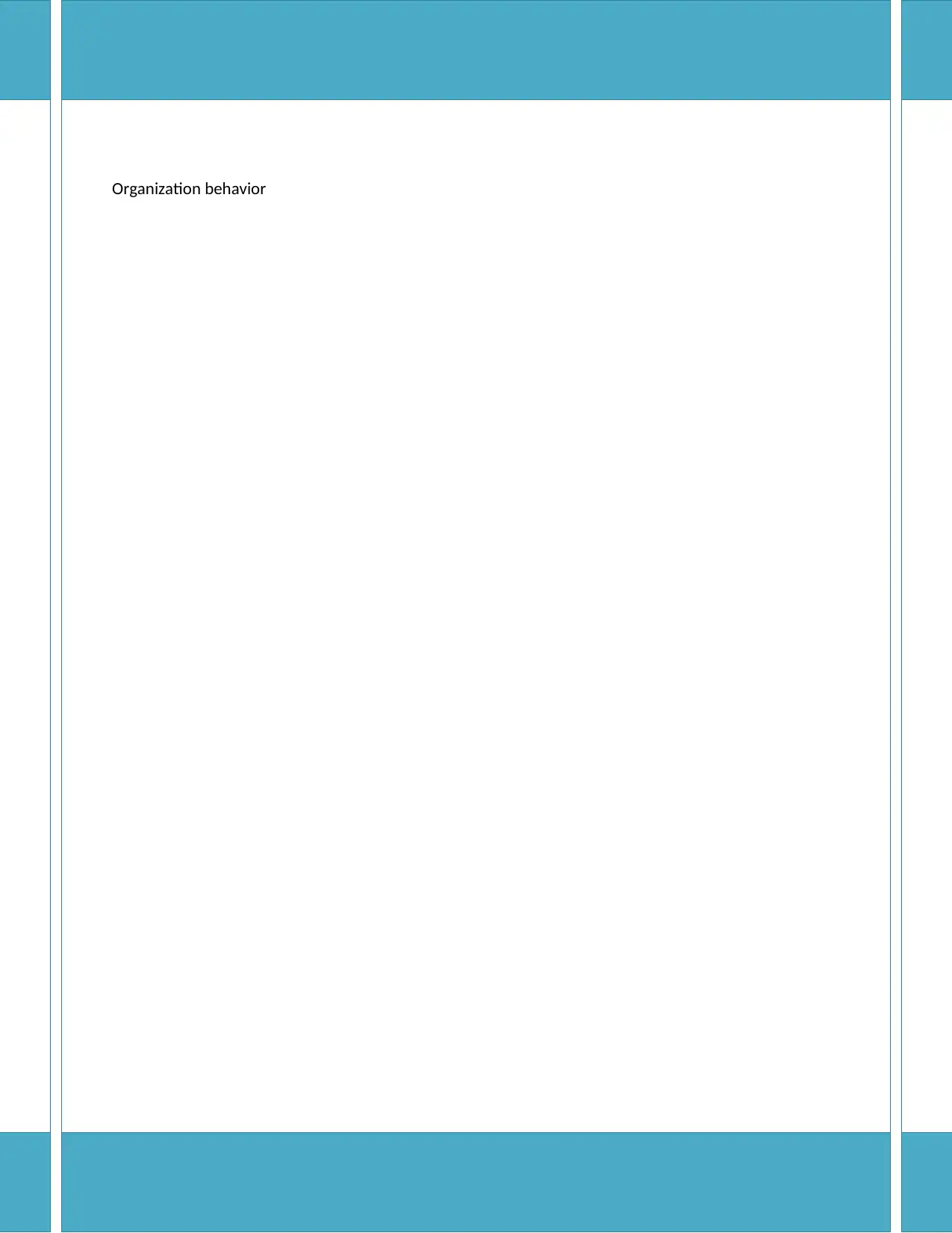
Organization behavior
Paraphrase This Document
Need a fresh take? Get an instant paraphrase of this document with our AI Paraphraser
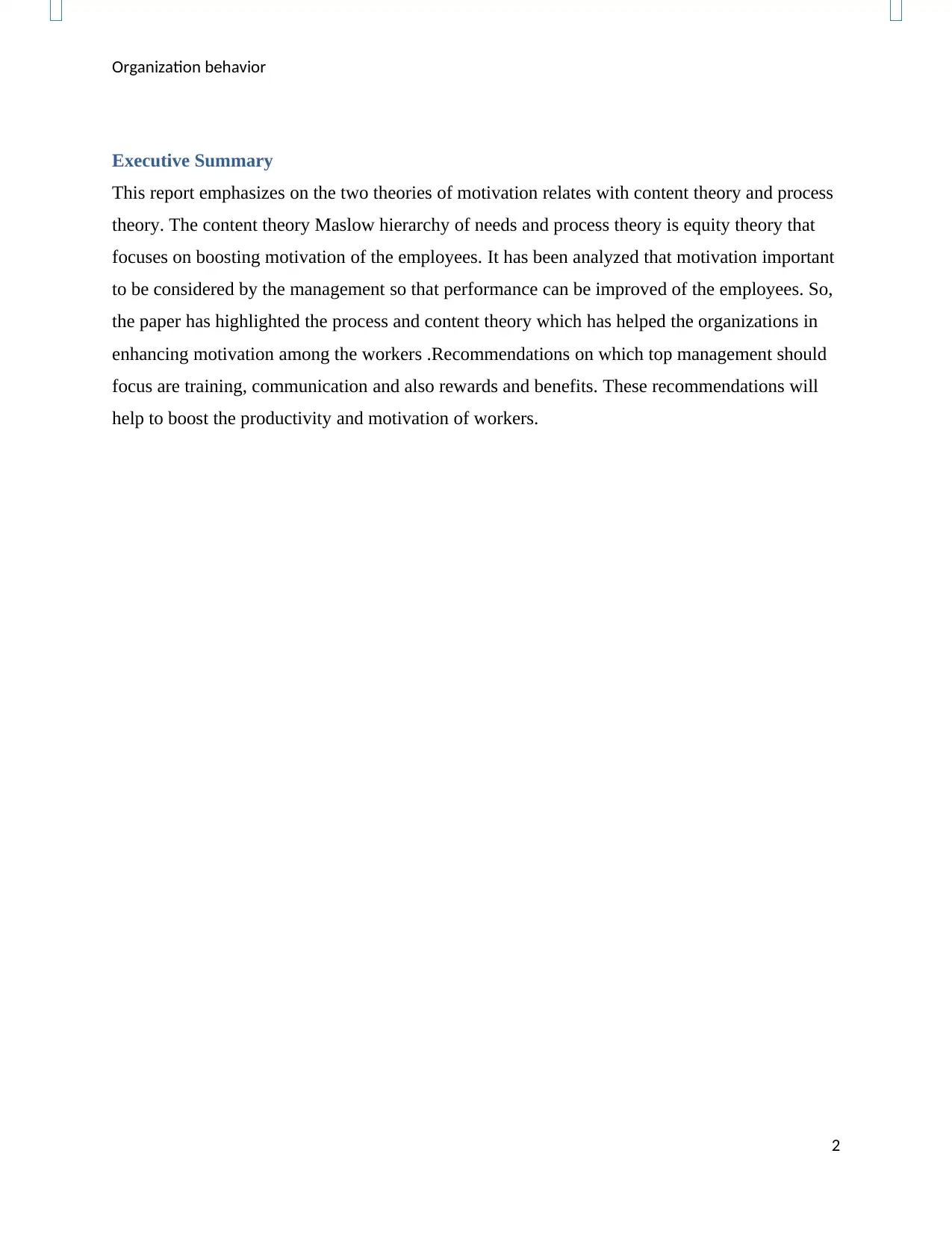
Organization behavior
Executive Summary
This report emphasizes on the two theories of motivation relates with content theory and process
theory. The content theory Maslow hierarchy of needs and process theory is equity theory that
focuses on boosting motivation of the employees. It has been analyzed that motivation important
to be considered by the management so that performance can be improved of the employees. So,
the paper has highlighted the process and content theory which has helped the organizations in
enhancing motivation among the workers .Recommendations on which top management should
focus are training, communication and also rewards and benefits. These recommendations will
help to boost the productivity and motivation of workers.
2
Executive Summary
This report emphasizes on the two theories of motivation relates with content theory and process
theory. The content theory Maslow hierarchy of needs and process theory is equity theory that
focuses on boosting motivation of the employees. It has been analyzed that motivation important
to be considered by the management so that performance can be improved of the employees. So,
the paper has highlighted the process and content theory which has helped the organizations in
enhancing motivation among the workers .Recommendations on which top management should
focus are training, communication and also rewards and benefits. These recommendations will
help to boost the productivity and motivation of workers.
2
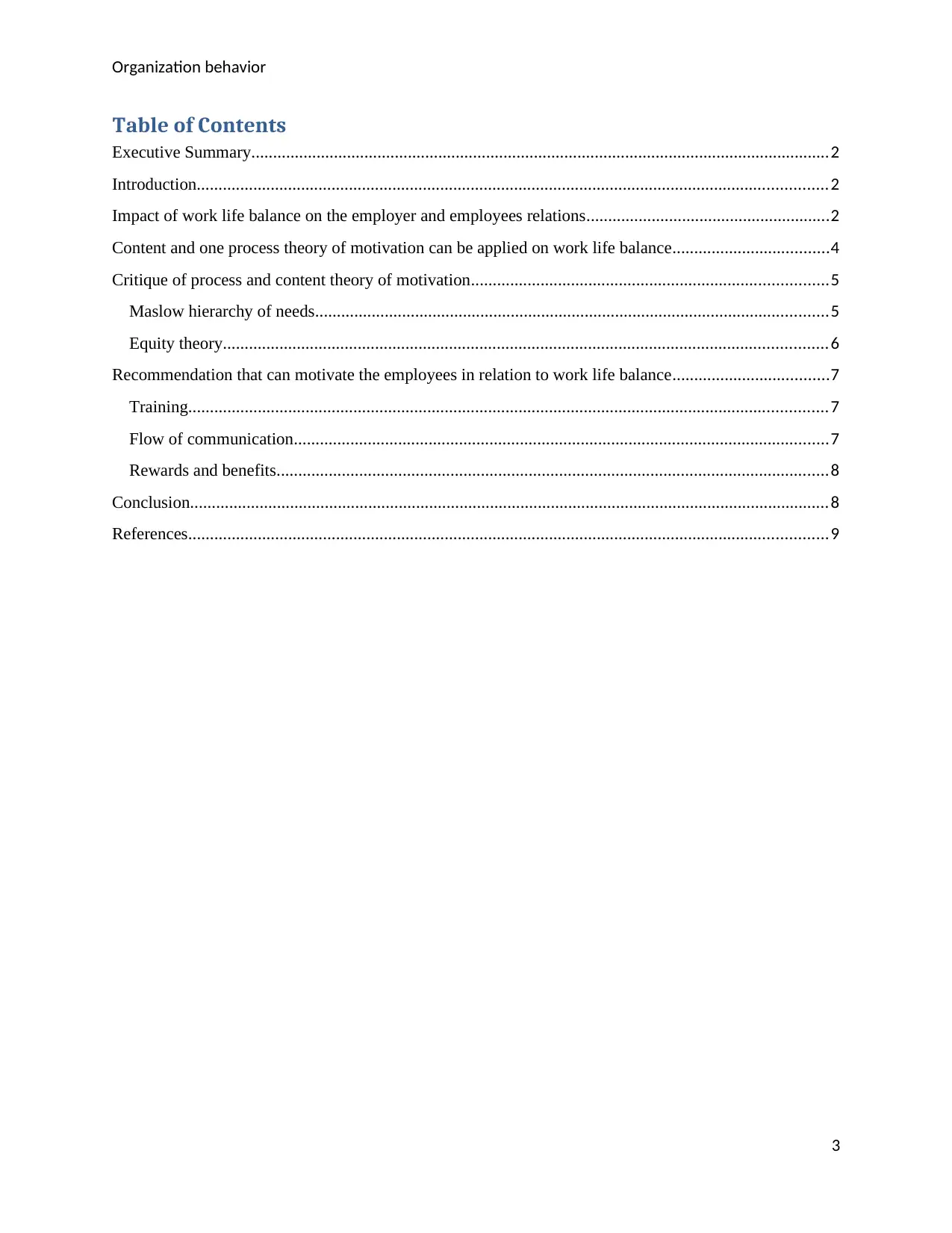
Organization behavior
Table of Contents
Executive Summary.....................................................................................................................................2
Introduction.................................................................................................................................................2
Impact of work life balance on the employer and employees relations........................................................2
Content and one process theory of motivation can be applied on work life balance....................................4
Critique of process and content theory of motivation..................................................................................5
Maslow hierarchy of needs......................................................................................................................5
Equity theory...........................................................................................................................................6
Recommendation that can motivate the employees in relation to work life balance....................................7
Training...................................................................................................................................................7
Flow of communication...........................................................................................................................7
Rewards and benefits...............................................................................................................................8
Conclusion...................................................................................................................................................8
References...................................................................................................................................................9
3
Table of Contents
Executive Summary.....................................................................................................................................2
Introduction.................................................................................................................................................2
Impact of work life balance on the employer and employees relations........................................................2
Content and one process theory of motivation can be applied on work life balance....................................4
Critique of process and content theory of motivation..................................................................................5
Maslow hierarchy of needs......................................................................................................................5
Equity theory...........................................................................................................................................6
Recommendation that can motivate the employees in relation to work life balance....................................7
Training...................................................................................................................................................7
Flow of communication...........................................................................................................................7
Rewards and benefits...............................................................................................................................8
Conclusion...................................................................................................................................................8
References...................................................................................................................................................9
3
⊘ This is a preview!⊘
Do you want full access?
Subscribe today to unlock all pages.

Trusted by 1+ million students worldwide
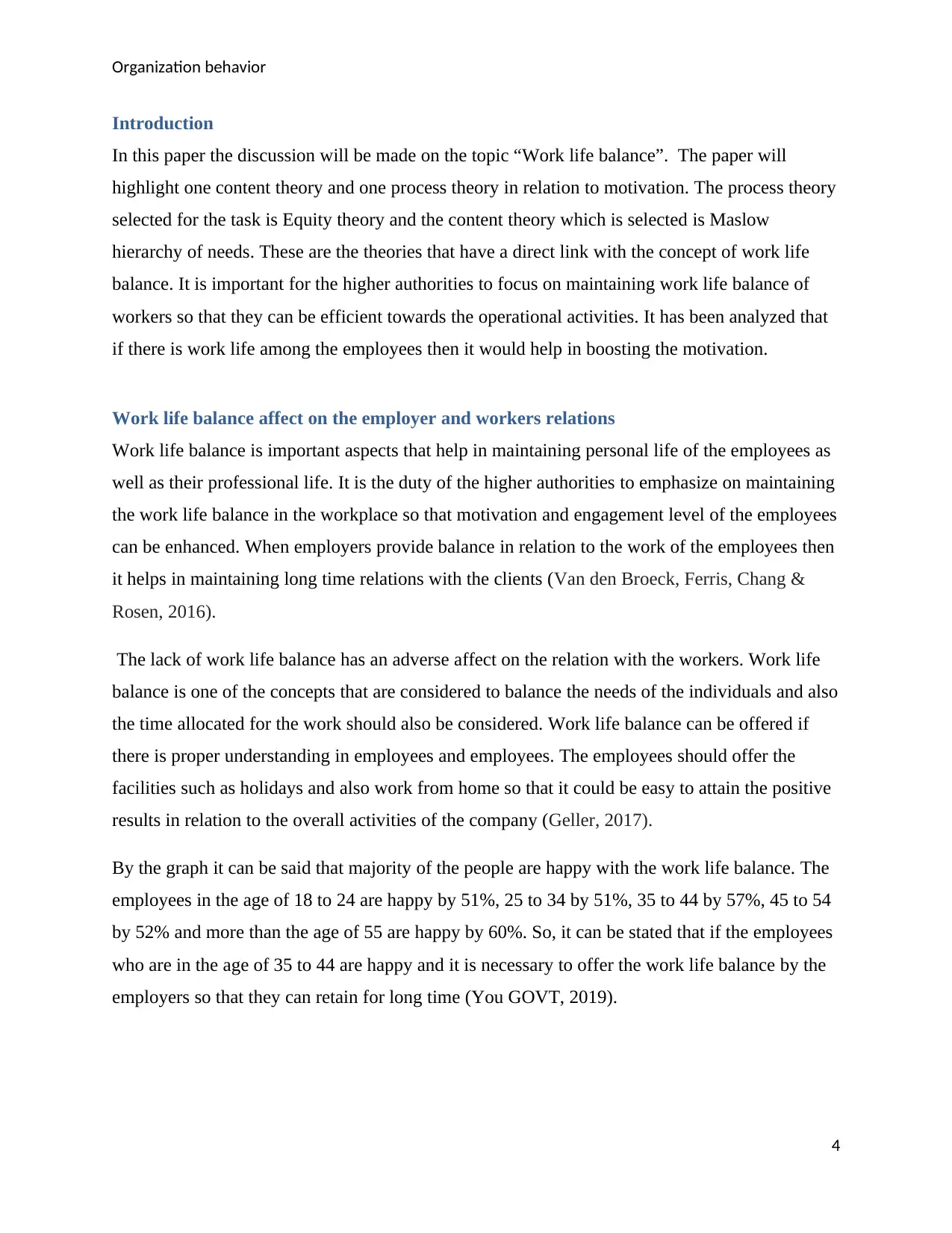
Organization behavior
Introduction
In this paper the discussion will be made on the topic “Work life balance”. The paper will
highlight one content theory and one process theory in relation to motivation. The process theory
selected for the task is Equity theory and the content theory which is selected is Maslow
hierarchy of needs. These are the theories that have a direct link with the concept of work life
balance. It is important for the higher authorities to focus on maintaining work life balance of
workers so that they can be efficient towards the operational activities. It has been analyzed that
if there is work life among the employees then it would help in boosting the motivation.
Work life balance affect on the employer and workers relations
Work life balance is important aspects that help in maintaining personal life of the employees as
well as their professional life. It is the duty of the higher authorities to emphasize on maintaining
the work life balance in the workplace so that motivation and engagement level of the employees
can be enhanced. When employers provide balance in relation to the work of the employees then
it helps in maintaining long time relations with the clients (Van den Broeck, Ferris, Chang &
Rosen, 2016).
The lack of work life balance has an adverse affect on the relation with the workers. Work life
balance is one of the concepts that are considered to balance the needs of the individuals and also
the time allocated for the work should also be considered. Work life balance can be offered if
there is proper understanding in employees and employees. The employees should offer the
facilities such as holidays and also work from home so that it could be easy to attain the positive
results in relation to the overall activities of the company (Geller, 2017).
By the graph it can be said that majority of the people are happy with the work life balance. The
employees in the age of 18 to 24 are happy by 51%, 25 to 34 by 51%, 35 to 44 by 57%, 45 to 54
by 52% and more than the age of 55 are happy by 60%. So, it can be stated that if the employees
who are in the age of 35 to 44 are happy and it is necessary to offer the work life balance by the
employers so that they can retain for long time (You GOVT, 2019).
4
Introduction
In this paper the discussion will be made on the topic “Work life balance”. The paper will
highlight one content theory and one process theory in relation to motivation. The process theory
selected for the task is Equity theory and the content theory which is selected is Maslow
hierarchy of needs. These are the theories that have a direct link with the concept of work life
balance. It is important for the higher authorities to focus on maintaining work life balance of
workers so that they can be efficient towards the operational activities. It has been analyzed that
if there is work life among the employees then it would help in boosting the motivation.
Work life balance affect on the employer and workers relations
Work life balance is important aspects that help in maintaining personal life of the employees as
well as their professional life. It is the duty of the higher authorities to emphasize on maintaining
the work life balance in the workplace so that motivation and engagement level of the employees
can be enhanced. When employers provide balance in relation to the work of the employees then
it helps in maintaining long time relations with the clients (Van den Broeck, Ferris, Chang &
Rosen, 2016).
The lack of work life balance has an adverse affect on the relation with the workers. Work life
balance is one of the concepts that are considered to balance the needs of the individuals and also
the time allocated for the work should also be considered. Work life balance can be offered if
there is proper understanding in employees and employees. The employees should offer the
facilities such as holidays and also work from home so that it could be easy to attain the positive
results in relation to the overall activities of the company (Geller, 2017).
By the graph it can be said that majority of the people are happy with the work life balance. The
employees in the age of 18 to 24 are happy by 51%, 25 to 34 by 51%, 35 to 44 by 57%, 45 to 54
by 52% and more than the age of 55 are happy by 60%. So, it can be stated that if the employees
who are in the age of 35 to 44 are happy and it is necessary to offer the work life balance by the
employers so that they can retain for long time (You GOVT, 2019).
4
Paraphrase This Document
Need a fresh take? Get an instant paraphrase of this document with our AI Paraphraser
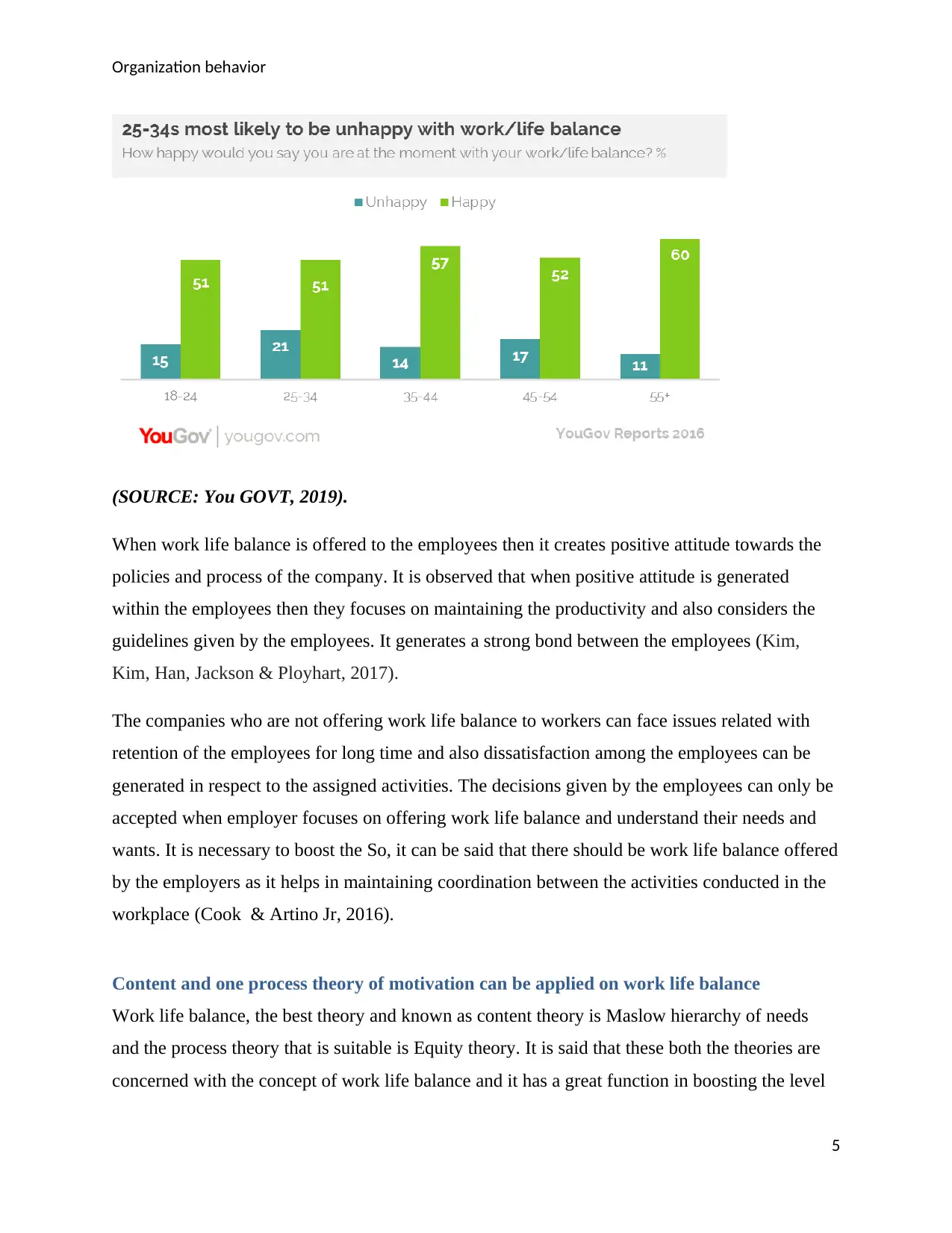
Organization behavior
(SOURCE: You GOVT, 2019).
When work life balance is offered to the employees then it creates positive attitude towards the
policies and process of the company. It is observed that when positive attitude is generated
within the employees then they focuses on maintaining the productivity and also considers the
guidelines given by the employees. It generates a strong bond between the employees (Kim,
Kim, Han, Jackson & Ployhart, 2017).
The companies who are not offering work life balance to workers can face issues related with
retention of the employees for long time and also dissatisfaction among the employees can be
generated in respect to the assigned activities. The decisions given by the employees can only be
accepted when employer focuses on offering work life balance and understand their needs and
wants. It is necessary to boost the So, it can be said that there should be work life balance offered
by the employers as it helps in maintaining coordination between the activities conducted in the
workplace (Cook & Artino Jr, 2016).
Content and one process theory of motivation can be applied on work life balance
Work life balance, the best theory and known as content theory is Maslow hierarchy of needs
and the process theory that is suitable is Equity theory. It is said that these both the theories are
concerned with the concept of work life balance and it has a great function in boosting the level
5
(SOURCE: You GOVT, 2019).
When work life balance is offered to the employees then it creates positive attitude towards the
policies and process of the company. It is observed that when positive attitude is generated
within the employees then they focuses on maintaining the productivity and also considers the
guidelines given by the employees. It generates a strong bond between the employees (Kim,
Kim, Han, Jackson & Ployhart, 2017).
The companies who are not offering work life balance to workers can face issues related with
retention of the employees for long time and also dissatisfaction among the employees can be
generated in respect to the assigned activities. The decisions given by the employees can only be
accepted when employer focuses on offering work life balance and understand their needs and
wants. It is necessary to boost the So, it can be said that there should be work life balance offered
by the employers as it helps in maintaining coordination between the activities conducted in the
workplace (Cook & Artino Jr, 2016).
Content and one process theory of motivation can be applied on work life balance
Work life balance, the best theory and known as content theory is Maslow hierarchy of needs
and the process theory that is suitable is Equity theory. It is said that these both the theories are
concerned with the concept of work life balance and it has a great function in boosting the level
5
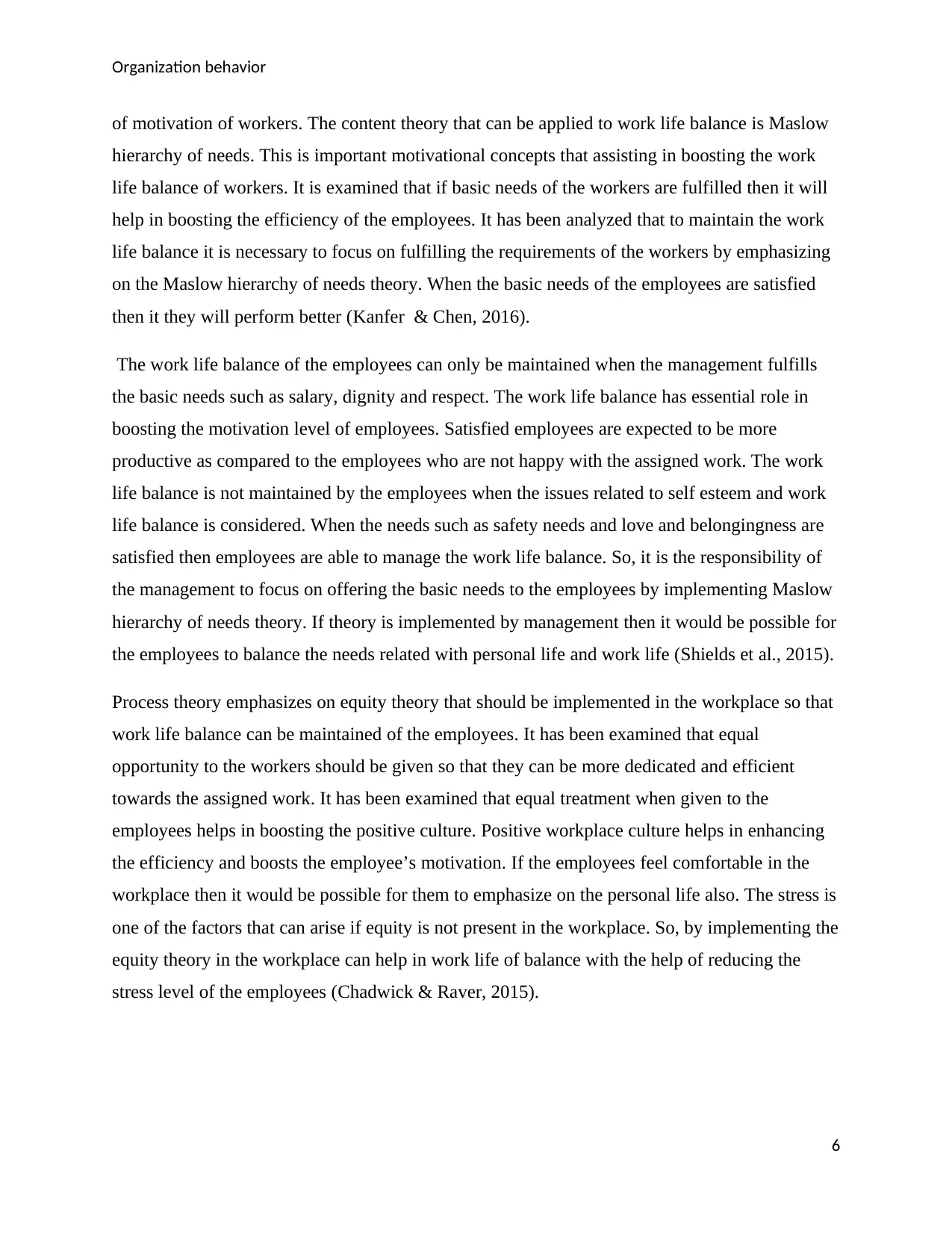
Organization behavior
of motivation of workers. The content theory that can be applied to work life balance is Maslow
hierarchy of needs. This is important motivational concepts that assisting in boosting the work
life balance of workers. It is examined that if basic needs of the workers are fulfilled then it will
help in boosting the efficiency of the employees. It has been analyzed that to maintain the work
life balance it is necessary to focus on fulfilling the requirements of the workers by emphasizing
on the Maslow hierarchy of needs theory. When the basic needs of the employees are satisfied
then it they will perform better (Kanfer & Chen, 2016).
The work life balance of the employees can only be maintained when the management fulfills
the basic needs such as salary, dignity and respect. The work life balance has essential role in
boosting the motivation level of employees. Satisfied employees are expected to be more
productive as compared to the employees who are not happy with the assigned work. The work
life balance is not maintained by the employees when the issues related to self esteem and work
life balance is considered. When the needs such as safety needs and love and belongingness are
satisfied then employees are able to manage the work life balance. So, it is the responsibility of
the management to focus on offering the basic needs to the employees by implementing Maslow
hierarchy of needs theory. If theory is implemented by management then it would be possible for
the employees to balance the needs related with personal life and work life (Shields et al., 2015).
Process theory emphasizes on equity theory that should be implemented in the workplace so that
work life balance can be maintained of the employees. It has been examined that equal
opportunity to the workers should be given so that they can be more dedicated and efficient
towards the assigned work. It has been examined that equal treatment when given to the
employees helps in boosting the positive culture. Positive workplace culture helps in enhancing
the efficiency and boosts the employee’s motivation. If the employees feel comfortable in the
workplace then it would be possible for them to emphasize on the personal life also. The stress is
one of the factors that can arise if equity is not present in the workplace. So, by implementing the
equity theory in the workplace can help in work life of balance with the help of reducing the
stress level of the employees (Chadwick & Raver, 2015).
6
of motivation of workers. The content theory that can be applied to work life balance is Maslow
hierarchy of needs. This is important motivational concepts that assisting in boosting the work
life balance of workers. It is examined that if basic needs of the workers are fulfilled then it will
help in boosting the efficiency of the employees. It has been analyzed that to maintain the work
life balance it is necessary to focus on fulfilling the requirements of the workers by emphasizing
on the Maslow hierarchy of needs theory. When the basic needs of the employees are satisfied
then it they will perform better (Kanfer & Chen, 2016).
The work life balance of the employees can only be maintained when the management fulfills
the basic needs such as salary, dignity and respect. The work life balance has essential role in
boosting the motivation level of employees. Satisfied employees are expected to be more
productive as compared to the employees who are not happy with the assigned work. The work
life balance is not maintained by the employees when the issues related to self esteem and work
life balance is considered. When the needs such as safety needs and love and belongingness are
satisfied then employees are able to manage the work life balance. So, it is the responsibility of
the management to focus on offering the basic needs to the employees by implementing Maslow
hierarchy of needs theory. If theory is implemented by management then it would be possible for
the employees to balance the needs related with personal life and work life (Shields et al., 2015).
Process theory emphasizes on equity theory that should be implemented in the workplace so that
work life balance can be maintained of the employees. It has been examined that equal
opportunity to the workers should be given so that they can be more dedicated and efficient
towards the assigned work. It has been examined that equal treatment when given to the
employees helps in boosting the positive culture. Positive workplace culture helps in enhancing
the efficiency and boosts the employee’s motivation. If the employees feel comfortable in the
workplace then it would be possible for them to emphasize on the personal life also. The stress is
one of the factors that can arise if equity is not present in the workplace. So, by implementing the
equity theory in the workplace can help in work life of balance with the help of reducing the
stress level of the employees (Chadwick & Raver, 2015).
6
⊘ This is a preview!⊘
Do you want full access?
Subscribe today to unlock all pages.

Trusted by 1+ million students worldwide
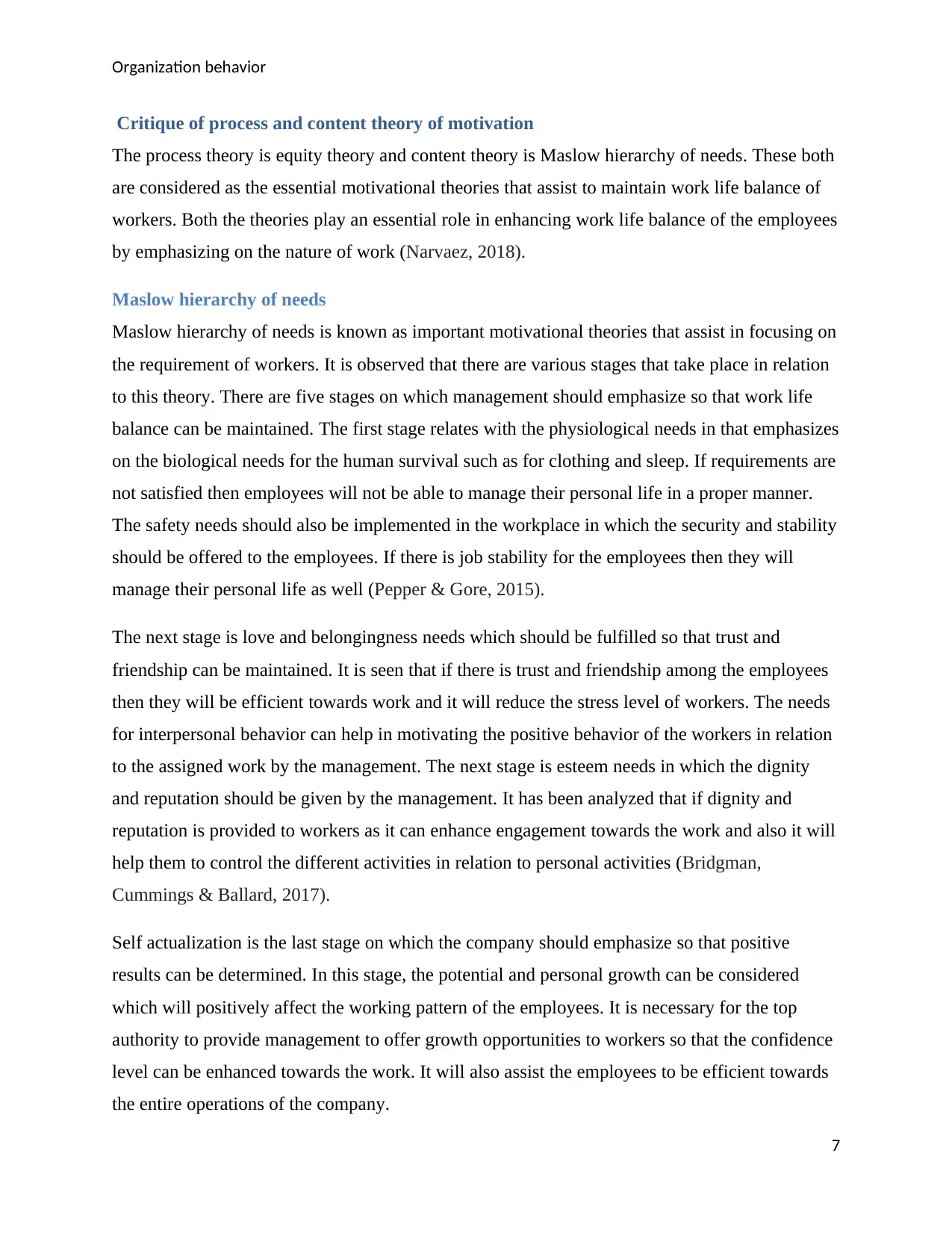
Organization behavior
Critique of process and content theory of motivation
The process theory is equity theory and content theory is Maslow hierarchy of needs. These both
are considered as the essential motivational theories that assist to maintain work life balance of
workers. Both the theories play an essential role in enhancing work life balance of the employees
by emphasizing on the nature of work (Narvaez, 2018).
Maslow hierarchy of needs
Maslow hierarchy of needs is known as important motivational theories that assist in focusing on
the requirement of workers. It is observed that there are various stages that take place in relation
to this theory. There are five stages on which management should emphasize so that work life
balance can be maintained. The first stage relates with the physiological needs in that emphasizes
on the biological needs for the human survival such as for clothing and sleep. If requirements are
not satisfied then employees will not be able to manage their personal life in a proper manner.
The safety needs should also be implemented in the workplace in which the security and stability
should be offered to the employees. If there is job stability for the employees then they will
manage their personal life as well (Pepper & Gore, 2015).
The next stage is love and belongingness needs which should be fulfilled so that trust and
friendship can be maintained. It is seen that if there is trust and friendship among the employees
then they will be efficient towards work and it will reduce the stress level of workers. The needs
for interpersonal behavior can help in motivating the positive behavior of the workers in relation
to the assigned work by the management. The next stage is esteem needs in which the dignity
and reputation should be given by the management. It has been analyzed that if dignity and
reputation is provided to workers as it can enhance engagement towards the work and also it will
help them to control the different activities in relation to personal activities (Bridgman,
Cummings & Ballard, 2017).
Self actualization is the last stage on which the company should emphasize so that positive
results can be determined. In this stage, the potential and personal growth can be considered
which will positively affect the working pattern of the employees. It is necessary for the top
authority to provide management to offer growth opportunities to workers so that the confidence
level can be enhanced towards the work. It will also assist the employees to be efficient towards
the entire operations of the company.
7
Critique of process and content theory of motivation
The process theory is equity theory and content theory is Maslow hierarchy of needs. These both
are considered as the essential motivational theories that assist to maintain work life balance of
workers. Both the theories play an essential role in enhancing work life balance of the employees
by emphasizing on the nature of work (Narvaez, 2018).
Maslow hierarchy of needs
Maslow hierarchy of needs is known as important motivational theories that assist in focusing on
the requirement of workers. It is observed that there are various stages that take place in relation
to this theory. There are five stages on which management should emphasize so that work life
balance can be maintained. The first stage relates with the physiological needs in that emphasizes
on the biological needs for the human survival such as for clothing and sleep. If requirements are
not satisfied then employees will not be able to manage their personal life in a proper manner.
The safety needs should also be implemented in the workplace in which the security and stability
should be offered to the employees. If there is job stability for the employees then they will
manage their personal life as well (Pepper & Gore, 2015).
The next stage is love and belongingness needs which should be fulfilled so that trust and
friendship can be maintained. It is seen that if there is trust and friendship among the employees
then they will be efficient towards work and it will reduce the stress level of workers. The needs
for interpersonal behavior can help in motivating the positive behavior of the workers in relation
to the assigned work by the management. The next stage is esteem needs in which the dignity
and reputation should be given by the management. It has been analyzed that if dignity and
reputation is provided to workers as it can enhance engagement towards the work and also it will
help them to control the different activities in relation to personal activities (Bridgman,
Cummings & Ballard, 2017).
Self actualization is the last stage on which the company should emphasize so that positive
results can be determined. In this stage, the potential and personal growth can be considered
which will positively affect the working pattern of the employees. It is necessary for the top
authority to provide management to offer growth opportunities to workers so that the confidence
level can be enhanced towards the work. It will also assist the employees to be efficient towards
the entire operations of the company.
7
Paraphrase This Document
Need a fresh take? Get an instant paraphrase of this document with our AI Paraphraser
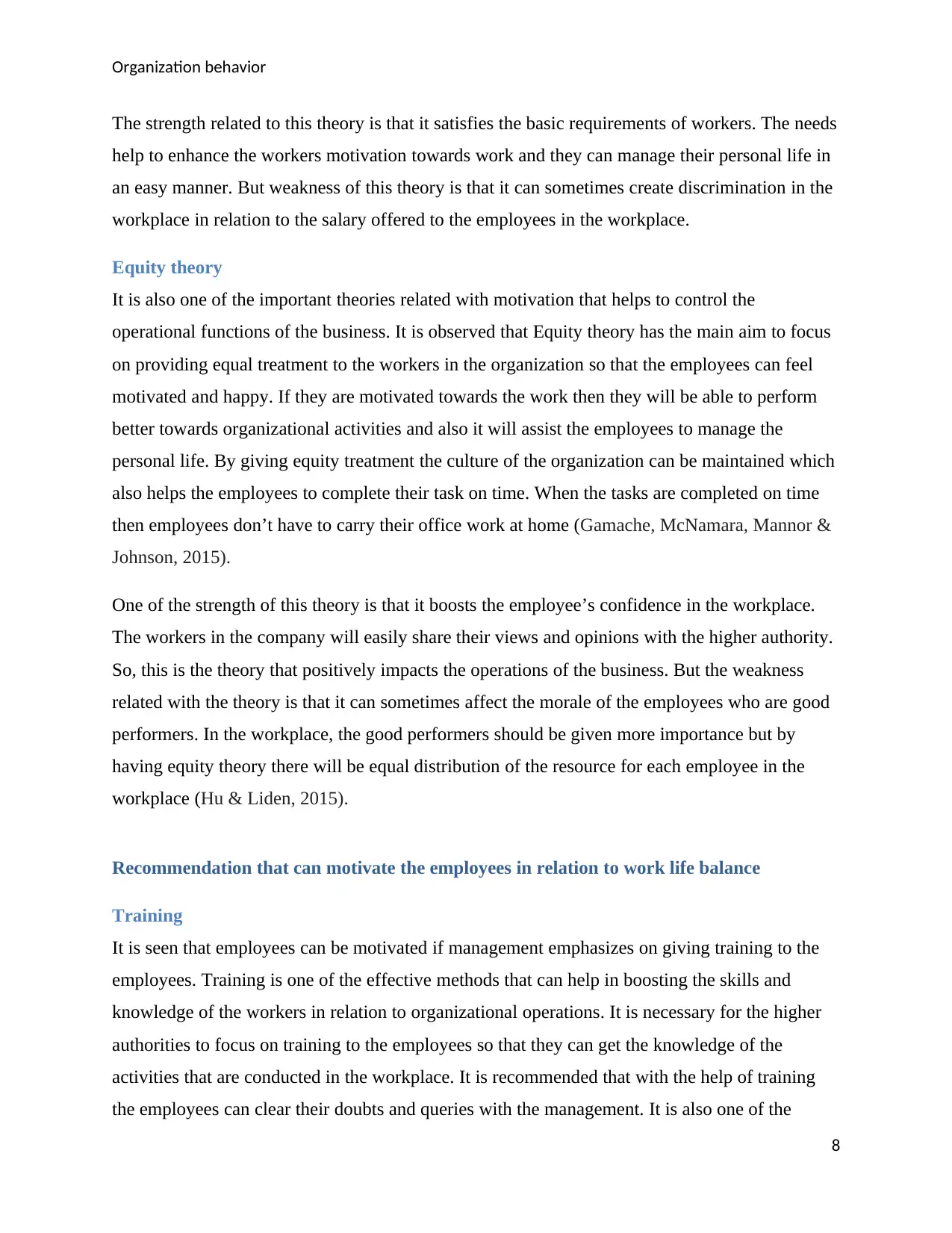
Organization behavior
The strength related to this theory is that it satisfies the basic requirements of workers. The needs
help to enhance the workers motivation towards work and they can manage their personal life in
an easy manner. But weakness of this theory is that it can sometimes create discrimination in the
workplace in relation to the salary offered to the employees in the workplace.
Equity theory
It is also one of the important theories related with motivation that helps to control the
operational functions of the business. It is observed that Equity theory has the main aim to focus
on providing equal treatment to the workers in the organization so that the employees can feel
motivated and happy. If they are motivated towards the work then they will be able to perform
better towards organizational activities and also it will assist the employees to manage the
personal life. By giving equity treatment the culture of the organization can be maintained which
also helps the employees to complete their task on time. When the tasks are completed on time
then employees don’t have to carry their office work at home (Gamache, McNamara, Mannor &
Johnson, 2015).
One of the strength of this theory is that it boosts the employee’s confidence in the workplace.
The workers in the company will easily share their views and opinions with the higher authority.
So, this is the theory that positively impacts the operations of the business. But the weakness
related with the theory is that it can sometimes affect the morale of the employees who are good
performers. In the workplace, the good performers should be given more importance but by
having equity theory there will be equal distribution of the resource for each employee in the
workplace (Hu & Liden, 2015).
Recommendation that can motivate the employees in relation to work life balance
Training
It is seen that employees can be motivated if management emphasizes on giving training to the
employees. Training is one of the effective methods that can help in boosting the skills and
knowledge of the workers in relation to organizational operations. It is necessary for the higher
authorities to focus on training to the employees so that they can get the knowledge of the
activities that are conducted in the workplace. It is recommended that with the help of training
the employees can clear their doubts and queries with the management. It is also one of the
8
The strength related to this theory is that it satisfies the basic requirements of workers. The needs
help to enhance the workers motivation towards work and they can manage their personal life in
an easy manner. But weakness of this theory is that it can sometimes create discrimination in the
workplace in relation to the salary offered to the employees in the workplace.
Equity theory
It is also one of the important theories related with motivation that helps to control the
operational functions of the business. It is observed that Equity theory has the main aim to focus
on providing equal treatment to the workers in the organization so that the employees can feel
motivated and happy. If they are motivated towards the work then they will be able to perform
better towards organizational activities and also it will assist the employees to manage the
personal life. By giving equity treatment the culture of the organization can be maintained which
also helps the employees to complete their task on time. When the tasks are completed on time
then employees don’t have to carry their office work at home (Gamache, McNamara, Mannor &
Johnson, 2015).
One of the strength of this theory is that it boosts the employee’s confidence in the workplace.
The workers in the company will easily share their views and opinions with the higher authority.
So, this is the theory that positively impacts the operations of the business. But the weakness
related with the theory is that it can sometimes affect the morale of the employees who are good
performers. In the workplace, the good performers should be given more importance but by
having equity theory there will be equal distribution of the resource for each employee in the
workplace (Hu & Liden, 2015).
Recommendation that can motivate the employees in relation to work life balance
Training
It is seen that employees can be motivated if management emphasizes on giving training to the
employees. Training is one of the effective methods that can help in boosting the skills and
knowledge of the workers in relation to organizational operations. It is necessary for the higher
authorities to focus on training to the employees so that they can get the knowledge of the
activities that are conducted in the workplace. It is recommended that with the help of training
the employees can clear their doubts and queries with the management. It is also one of the
8
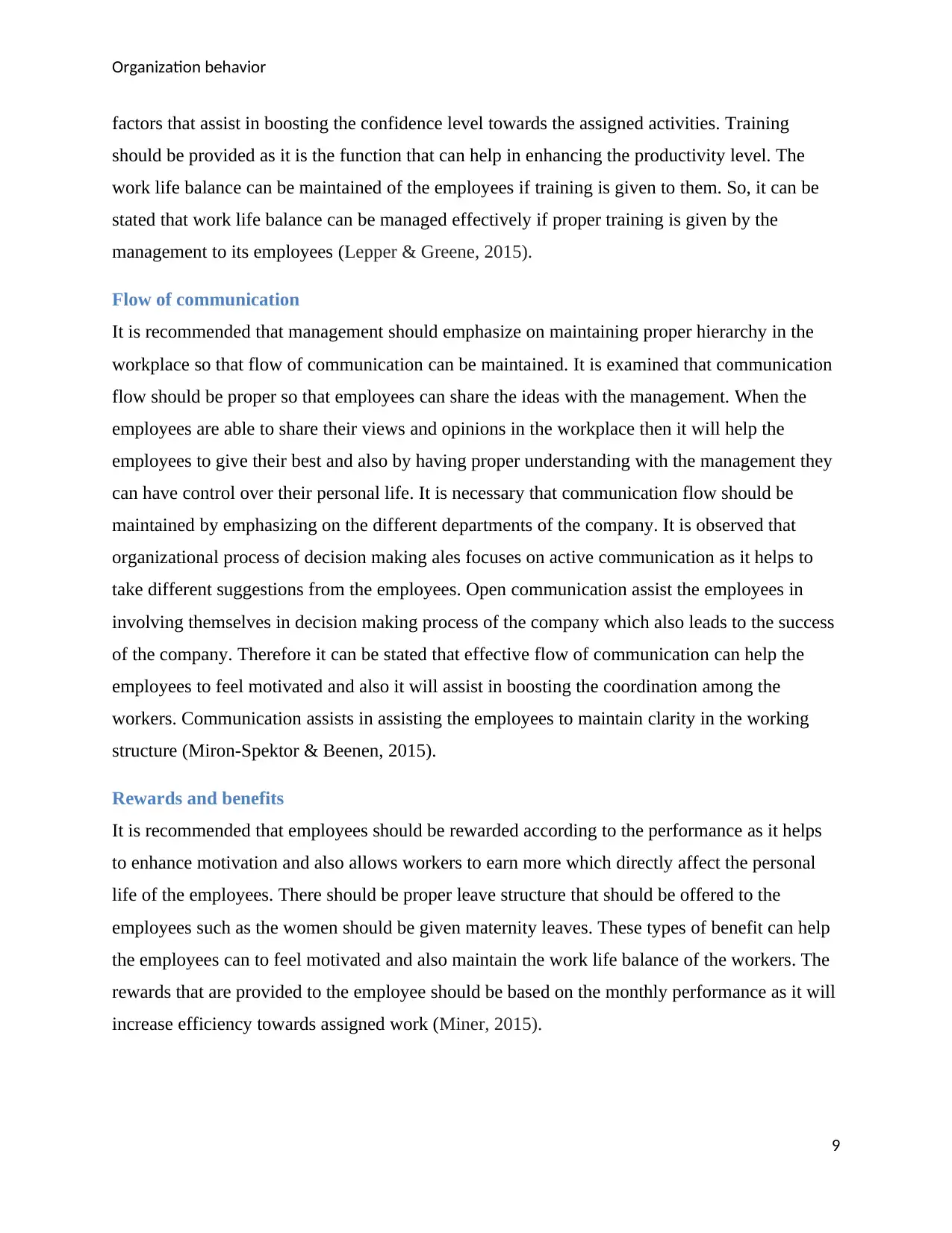
Organization behavior
factors that assist in boosting the confidence level towards the assigned activities. Training
should be provided as it is the function that can help in enhancing the productivity level. The
work life balance can be maintained of the employees if training is given to them. So, it can be
stated that work life balance can be managed effectively if proper training is given by the
management to its employees (Lepper & Greene, 2015).
Flow of communication
It is recommended that management should emphasize on maintaining proper hierarchy in the
workplace so that flow of communication can be maintained. It is examined that communication
flow should be proper so that employees can share the ideas with the management. When the
employees are able to share their views and opinions in the workplace then it will help the
employees to give their best and also by having proper understanding with the management they
can have control over their personal life. It is necessary that communication flow should be
maintained by emphasizing on the different departments of the company. It is observed that
organizational process of decision making ales focuses on active communication as it helps to
take different suggestions from the employees. Open communication assist the employees in
involving themselves in decision making process of the company which also leads to the success
of the company. Therefore it can be stated that effective flow of communication can help the
employees to feel motivated and also it will assist in boosting the coordination among the
workers. Communication assists in assisting the employees to maintain clarity in the working
structure (Miron-Spektor & Beenen, 2015).
Rewards and benefits
It is recommended that employees should be rewarded according to the performance as it helps
to enhance motivation and also allows workers to earn more which directly affect the personal
life of the employees. There should be proper leave structure that should be offered to the
employees such as the women should be given maternity leaves. These types of benefit can help
the employees can to feel motivated and also maintain the work life balance of the workers. The
rewards that are provided to the employee should be based on the monthly performance as it will
increase efficiency towards assigned work (Miner, 2015).
9
factors that assist in boosting the confidence level towards the assigned activities. Training
should be provided as it is the function that can help in enhancing the productivity level. The
work life balance can be maintained of the employees if training is given to them. So, it can be
stated that work life balance can be managed effectively if proper training is given by the
management to its employees (Lepper & Greene, 2015).
Flow of communication
It is recommended that management should emphasize on maintaining proper hierarchy in the
workplace so that flow of communication can be maintained. It is examined that communication
flow should be proper so that employees can share the ideas with the management. When the
employees are able to share their views and opinions in the workplace then it will help the
employees to give their best and also by having proper understanding with the management they
can have control over their personal life. It is necessary that communication flow should be
maintained by emphasizing on the different departments of the company. It is observed that
organizational process of decision making ales focuses on active communication as it helps to
take different suggestions from the employees. Open communication assist the employees in
involving themselves in decision making process of the company which also leads to the success
of the company. Therefore it can be stated that effective flow of communication can help the
employees to feel motivated and also it will assist in boosting the coordination among the
workers. Communication assists in assisting the employees to maintain clarity in the working
structure (Miron-Spektor & Beenen, 2015).
Rewards and benefits
It is recommended that employees should be rewarded according to the performance as it helps
to enhance motivation and also allows workers to earn more which directly affect the personal
life of the employees. There should be proper leave structure that should be offered to the
employees such as the women should be given maternity leaves. These types of benefit can help
the employees can to feel motivated and also maintain the work life balance of the workers. The
rewards that are provided to the employee should be based on the monthly performance as it will
increase efficiency towards assigned work (Miner, 2015).
9
⊘ This is a preview!⊘
Do you want full access?
Subscribe today to unlock all pages.

Trusted by 1+ million students worldwide
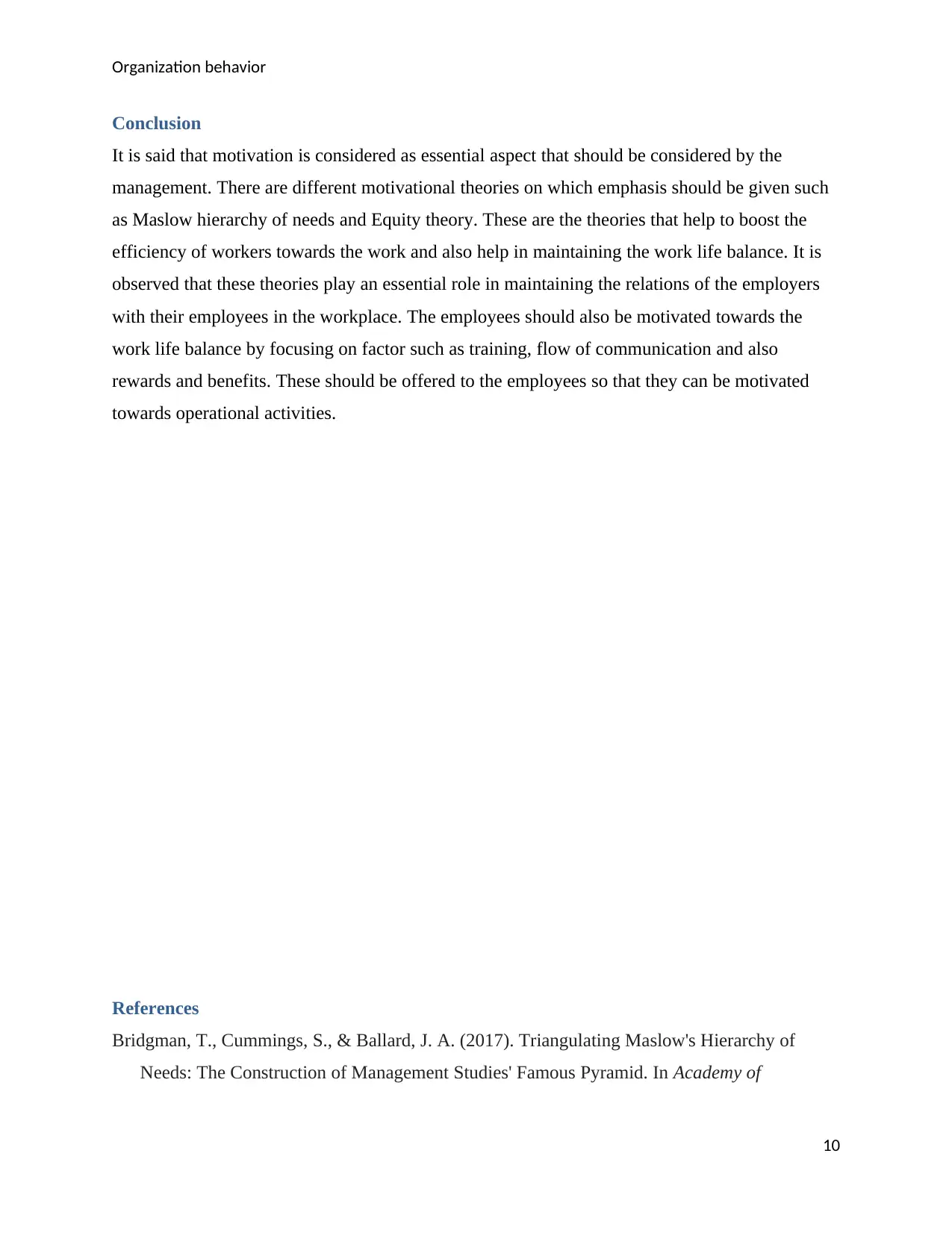
Organization behavior
Conclusion
It is said that motivation is considered as essential aspect that should be considered by the
management. There are different motivational theories on which emphasis should be given such
as Maslow hierarchy of needs and Equity theory. These are the theories that help to boost the
efficiency of workers towards the work and also help in maintaining the work life balance. It is
observed that these theories play an essential role in maintaining the relations of the employers
with their employees in the workplace. The employees should also be motivated towards the
work life balance by focusing on factor such as training, flow of communication and also
rewards and benefits. These should be offered to the employees so that they can be motivated
towards operational activities.
References
Bridgman, T., Cummings, S., & Ballard, J. A. (2017). Triangulating Maslow's Hierarchy of
Needs: The Construction of Management Studies' Famous Pyramid. In Academy of
10
Conclusion
It is said that motivation is considered as essential aspect that should be considered by the
management. There are different motivational theories on which emphasis should be given such
as Maslow hierarchy of needs and Equity theory. These are the theories that help to boost the
efficiency of workers towards the work and also help in maintaining the work life balance. It is
observed that these theories play an essential role in maintaining the relations of the employers
with their employees in the workplace. The employees should also be motivated towards the
work life balance by focusing on factor such as training, flow of communication and also
rewards and benefits. These should be offered to the employees so that they can be motivated
towards operational activities.
References
Bridgman, T., Cummings, S., & Ballard, J. A. (2017). Triangulating Maslow's Hierarchy of
Needs: The Construction of Management Studies' Famous Pyramid. In Academy of
10
Paraphrase This Document
Need a fresh take? Get an instant paraphrase of this document with our AI Paraphraser
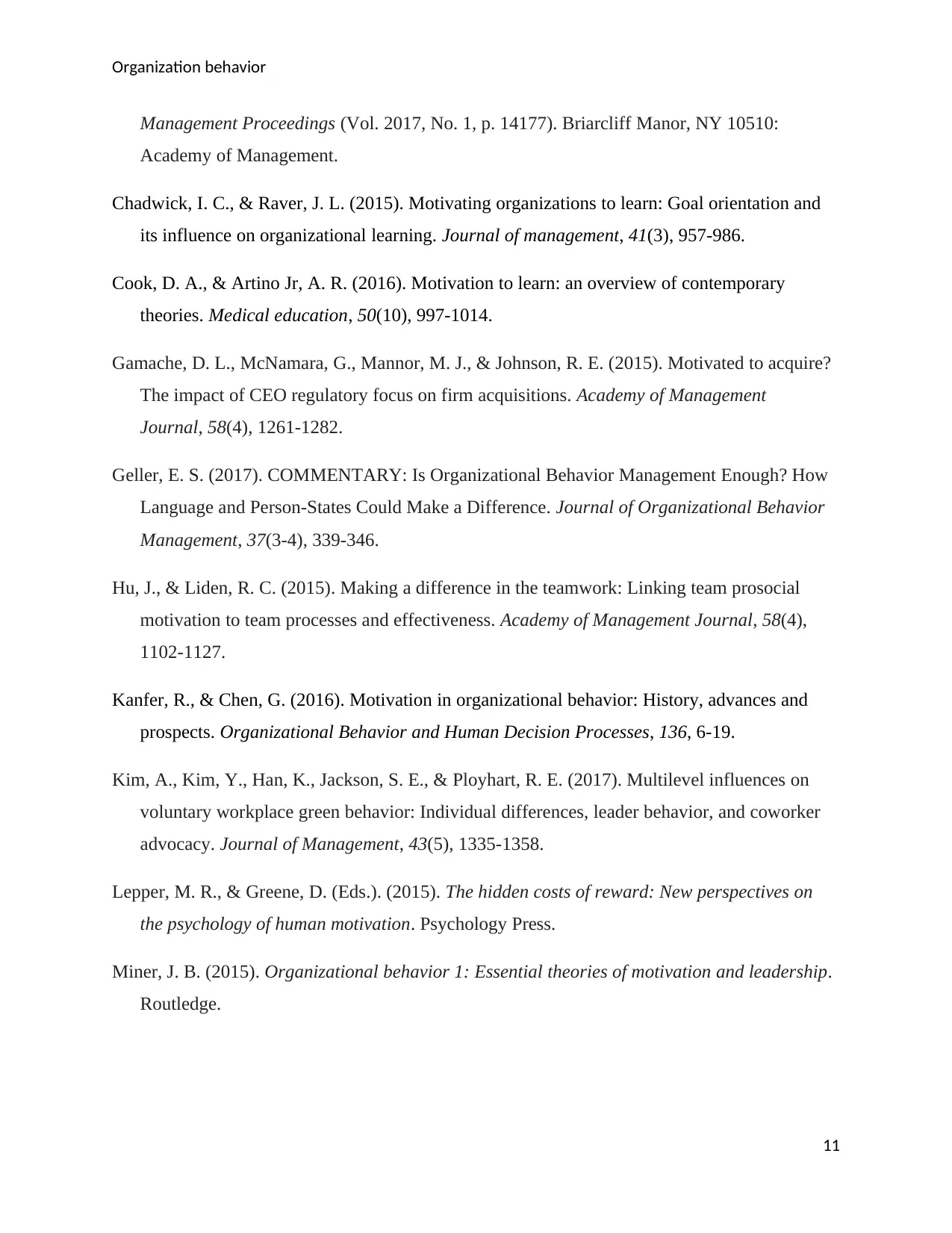
Organization behavior
Management Proceedings (Vol. 2017, No. 1, p. 14177). Briarcliff Manor, NY 10510:
Academy of Management.
Chadwick, I. C., & Raver, J. L. (2015). Motivating organizations to learn: Goal orientation and
its influence on organizational learning. Journal of management, 41(3), 957-986.
Cook, D. A., & Artino Jr, A. R. (2016). Motivation to learn: an overview of contemporary
theories. Medical education, 50(10), 997-1014.
Gamache, D. L., McNamara, G., Mannor, M. J., & Johnson, R. E. (2015). Motivated to acquire?
The impact of CEO regulatory focus on firm acquisitions. Academy of Management
Journal, 58(4), 1261-1282.
Geller, E. S. (2017). COMMENTARY: Is Organizational Behavior Management Enough? How
Language and Person-States Could Make a Difference. Journal of Organizational Behavior
Management, 37(3-4), 339-346.
Hu, J., & Liden, R. C. (2015). Making a difference in the teamwork: Linking team prosocial
motivation to team processes and effectiveness. Academy of Management Journal, 58(4),
1102-1127.
Kanfer, R., & Chen, G. (2016). Motivation in organizational behavior: History, advances and
prospects. Organizational Behavior and Human Decision Processes, 136, 6-19.
Kim, A., Kim, Y., Han, K., Jackson, S. E., & Ployhart, R. E. (2017). Multilevel influences on
voluntary workplace green behavior: Individual differences, leader behavior, and coworker
advocacy. Journal of Management, 43(5), 1335-1358.
Lepper, M. R., & Greene, D. (Eds.). (2015). The hidden costs of reward: New perspectives on
the psychology of human motivation. Psychology Press.
Miner, J. B. (2015). Organizational behavior 1: Essential theories of motivation and leadership.
Routledge.
11
Management Proceedings (Vol. 2017, No. 1, p. 14177). Briarcliff Manor, NY 10510:
Academy of Management.
Chadwick, I. C., & Raver, J. L. (2015). Motivating organizations to learn: Goal orientation and
its influence on organizational learning. Journal of management, 41(3), 957-986.
Cook, D. A., & Artino Jr, A. R. (2016). Motivation to learn: an overview of contemporary
theories. Medical education, 50(10), 997-1014.
Gamache, D. L., McNamara, G., Mannor, M. J., & Johnson, R. E. (2015). Motivated to acquire?
The impact of CEO regulatory focus on firm acquisitions. Academy of Management
Journal, 58(4), 1261-1282.
Geller, E. S. (2017). COMMENTARY: Is Organizational Behavior Management Enough? How
Language and Person-States Could Make a Difference. Journal of Organizational Behavior
Management, 37(3-4), 339-346.
Hu, J., & Liden, R. C. (2015). Making a difference in the teamwork: Linking team prosocial
motivation to team processes and effectiveness. Academy of Management Journal, 58(4),
1102-1127.
Kanfer, R., & Chen, G. (2016). Motivation in organizational behavior: History, advances and
prospects. Organizational Behavior and Human Decision Processes, 136, 6-19.
Kim, A., Kim, Y., Han, K., Jackson, S. E., & Ployhart, R. E. (2017). Multilevel influences on
voluntary workplace green behavior: Individual differences, leader behavior, and coworker
advocacy. Journal of Management, 43(5), 1335-1358.
Lepper, M. R., & Greene, D. (Eds.). (2015). The hidden costs of reward: New perspectives on
the psychology of human motivation. Psychology Press.
Miner, J. B. (2015). Organizational behavior 1: Essential theories of motivation and leadership.
Routledge.
11
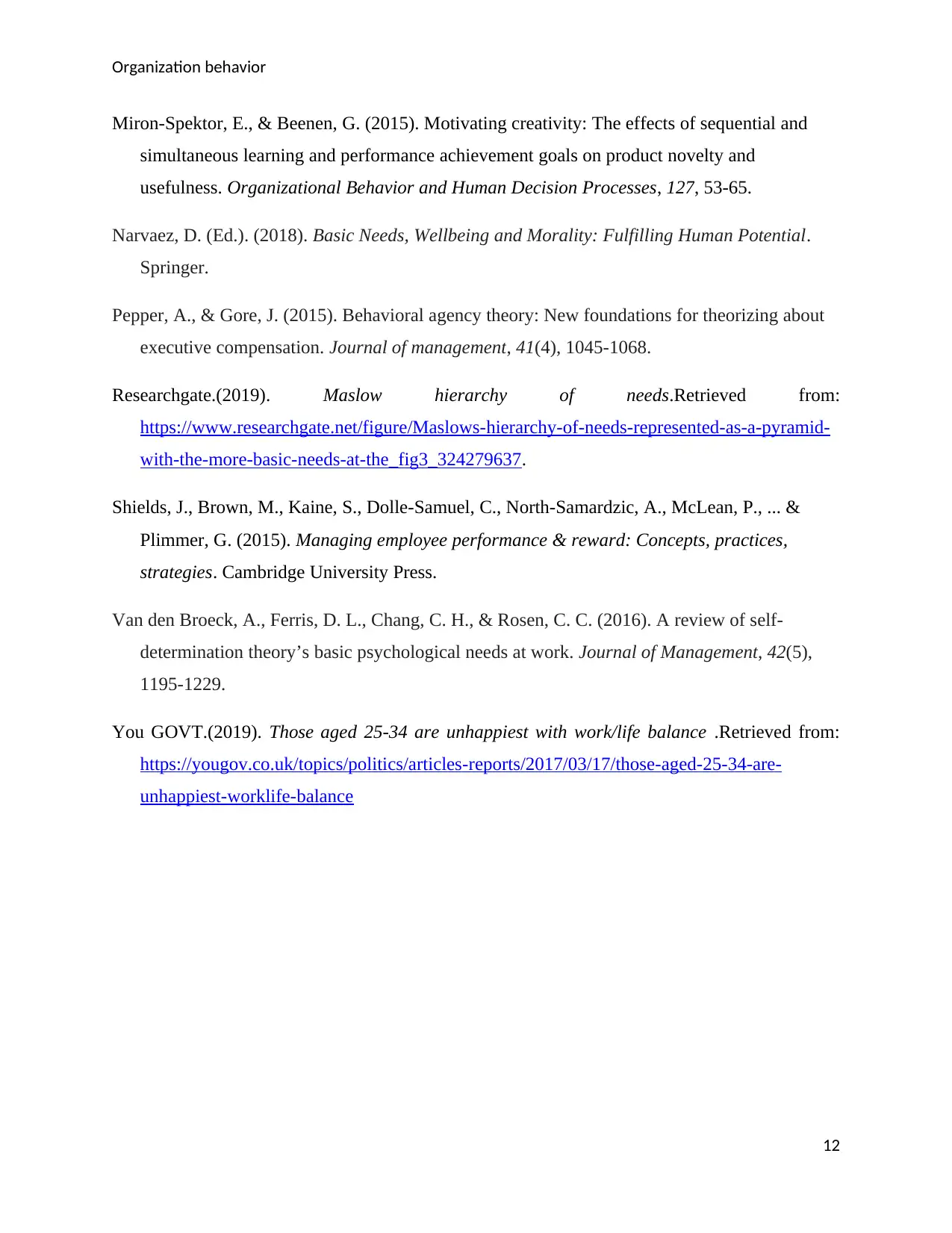
Organization behavior
Miron-Spektor, E., & Beenen, G. (2015). Motivating creativity: The effects of sequential and
simultaneous learning and performance achievement goals on product novelty and
usefulness. Organizational Behavior and Human Decision Processes, 127, 53-65.
Narvaez, D. (Ed.). (2018). Basic Needs, Wellbeing and Morality: Fulfilling Human Potential.
Springer.
Pepper, A., & Gore, J. (2015). Behavioral agency theory: New foundations for theorizing about
executive compensation. Journal of management, 41(4), 1045-1068.
Researchgate.(2019). Maslow hierarchy of needs.Retrieved from:
https://www.researchgate.net/figure/Maslows-hierarchy-of-needs-represented-as-a-pyramid-
with-the-more-basic-needs-at-the_fig3_324279637.
Shields, J., Brown, M., Kaine, S., Dolle-Samuel, C., North-Samardzic, A., McLean, P., ... &
Plimmer, G. (2015). Managing employee performance & reward: Concepts, practices,
strategies. Cambridge University Press.
Van den Broeck, A., Ferris, D. L., Chang, C. H., & Rosen, C. C. (2016). A review of self-
determination theory’s basic psychological needs at work. Journal of Management, 42(5),
1195-1229.
You GOVT.(2019). Those aged 25-34 are unhappiest with work/life balance .Retrieved from:
https://yougov.co.uk/topics/politics/articles-reports/2017/03/17/those-aged-25-34-are-
unhappiest-worklife-balance
12
Miron-Spektor, E., & Beenen, G. (2015). Motivating creativity: The effects of sequential and
simultaneous learning and performance achievement goals on product novelty and
usefulness. Organizational Behavior and Human Decision Processes, 127, 53-65.
Narvaez, D. (Ed.). (2018). Basic Needs, Wellbeing and Morality: Fulfilling Human Potential.
Springer.
Pepper, A., & Gore, J. (2015). Behavioral agency theory: New foundations for theorizing about
executive compensation. Journal of management, 41(4), 1045-1068.
Researchgate.(2019). Maslow hierarchy of needs.Retrieved from:
https://www.researchgate.net/figure/Maslows-hierarchy-of-needs-represented-as-a-pyramid-
with-the-more-basic-needs-at-the_fig3_324279637.
Shields, J., Brown, M., Kaine, S., Dolle-Samuel, C., North-Samardzic, A., McLean, P., ... &
Plimmer, G. (2015). Managing employee performance & reward: Concepts, practices,
strategies. Cambridge University Press.
Van den Broeck, A., Ferris, D. L., Chang, C. H., & Rosen, C. C. (2016). A review of self-
determination theory’s basic psychological needs at work. Journal of Management, 42(5),
1195-1229.
You GOVT.(2019). Those aged 25-34 are unhappiest with work/life balance .Retrieved from:
https://yougov.co.uk/topics/politics/articles-reports/2017/03/17/those-aged-25-34-are-
unhappiest-worklife-balance
12
⊘ This is a preview!⊘
Do you want full access?
Subscribe today to unlock all pages.

Trusted by 1+ million students worldwide
1 out of 12
Related Documents
Your All-in-One AI-Powered Toolkit for Academic Success.
+13062052269
info@desklib.com
Available 24*7 on WhatsApp / Email
![[object Object]](/_next/static/media/star-bottom.7253800d.svg)
Unlock your academic potential
Copyright © 2020–2025 A2Z Services. All Rights Reserved. Developed and managed by ZUCOL.





